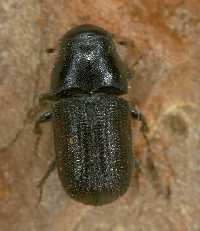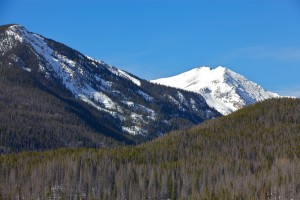This post is the second in a series called “Trees in Trouble”. To see the first post in this series click here.
Climate impacts so many things on this planet, most notably the types of flora and fauna that live in a specific region. And for those creatures that have annual cycles tied to the local climate, such as the hibernation of bears, migration of birds, and life cycles of insects, a change in climate can shift their way of life and even have subsequent consequences on the environment they live in.
Take the pine beetle (Dendroctonus ponderosae) for example. In order to deposit her eggs, a female pine beetle digs a burrow deep into a pine tree. Pine beetles also carry a fungus with them that gets introduced to the tree during the attack. This fungus is what the larvae feed on during winter, however it is this fungus that kills the tree. Thus, once the beetles have targeted a pine tree, its fate is almost certainly doomed.

Top view of an adult mountain pine beetle (actual size is 1/8 to 1/3 inch). (From Colorado State University Extension Office)
While the pine beetle is native in the pine forests of North America, this past decade has seen its population increase tremendously. What else has been noteworthy of this past decade? It has been an incredibly hot period, relative to our historical records. One symptom of this climate change in places like the Rocky Mountains of North America has been an earlier onset to summer, after notably warm and mild springs.
Drier and hotter summers impact the health of the pine trees, leaving them weak and vulnerable to attack by beetles. Additionally, recent research has shown that when unseasonably hot weather occurs in early summer, pine beetles emerge from their larvae nests in pine trees much earlier as well. So much earlier, in fact, that they were even observed to have a second reproductive cycle yielding more adults later in the summer, resulting in two waves of beetles capable of attacking, and thus killing, pine trees in just one summer. Moreover, the warmer climate also allows the beetles to escape their most natural form of population control: fall and spring hard freezes or sustained periods of extremely cold (< -35 C) temperatures in winter.

Example of damage from pine beetle infestations in trees in Rocky Mountain National Park (taken January 2012, from Wikimedia Commons). Infested trees initially turn red and then eventually lose all of their needles, leaving them appearing gray in color.
The increase in pine beetle populations due to climate shifts certainly could be one of the reasons for the epidemic tree loss currently facing the Rocky Mountain pine forests. While there are some methods to control the spread of the pine beetle, many are labor intensive or not as effective when the outbreaks are occurring. Thus, it is hard to say what the future holds for the mountain pine forests and the ecosystems within which they reside.
Suggested Activity: Participate in the GLOBE Student Climate Research Campaign (SCRC) Climate and Land Cover project to help document how the forests in your region are changing! During four Intensive Observing Periods (IOPs) each year, GLOBE students use the land cover protocol to take photographs of land cover near their schools and upload these data to the GLOBE database. The April Climate and Land Cover project IOP is currently underway. We would love to see photographs of what is happening to the forests in your region! Send us an email at science@globe.gov or add a comment to let us know what you observe.
–Sarah Tessendorf

Thank you to tell us so much useful information. I’m glad to read it.